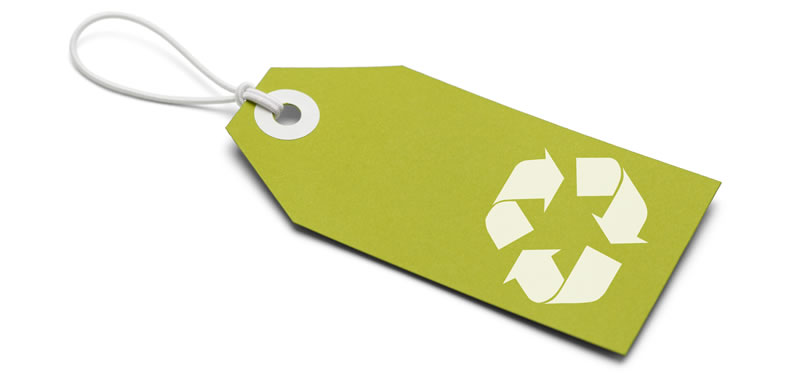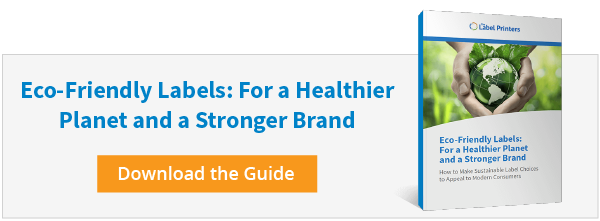
If you’re considering switching to more eco-friendly labels for your products or business, you’re riding a growing wave of public sentiment.
A survey published in 2020 reported that the majority of American Generation Z consumers – those born between 1995 and 2012 – would pay a premium of 10% or more for sustainable products. A similar percentage of millennials said they would do the same, along with 34% of Gen Xers and 23% of baby boomers.
Among those consumers willing to pay more for sustainability, 53% look for products with environmentally-friendly packaging. Driven by consumer demand, the global sustainable packaging market will exceed $400 billion in less than a decade, growing by 7.7% each year.
This provides a perfect opportunity for brands: Choosing sustainable labels (and an eco-friendly label supplier) can make a big difference to the environment and your bottom line. However, when choosing eco-friendly labels (eco-friendly anything, really), it’s hard to know which options truly are environmentally sustainable, and which might just be a “greenwashed” disaster.
That’s why we’ve put together some guidance on all the behind-the-scenes processes that affect your label’s overall sustainability – so you can make an informed choice that makes you (and your customers) feel good about making a difference.
Ready? Let’s dive in!
Choosing Eco-Friendly Label Materials
Eco-friendly labels are typically manufactured using earth-friendly materials and have been designed to reduce the carbon footprint of the company that makes them.
Sustainable choices for product labels include materials that are recycled, recyclable, or renewable. This can apply to the entire label or individual elements, such as the printing surface, the ink, or the adhesive.
It’s worth noting that, while the plastic, glass, or metal containers that hold your product may be recyclable, their labels (and label adhesive) may not be. Labels and adhesives are usually burned away during the recycling process. Regular paper labels may be recyclable if the consumer removes them, but the adhesive may gum up the works at the recycling plant.
Here are a few options for recycled and renewable materials for your product label:
- PLA labels. PLA stands for polylactic acid, a biodegradable polyester derived from renewable sources such as corn starch. PLA looks and behaves like petroleum-based plastics but won’t linger for centuries in landfills. Although PLA can’t be recycled, it biodegrades in just 60 days.
- Tree-free labels. The demand for paper continues to play a significant role in the demise of the world’s forests and rainforests. But paper-like products can be manufactured without trees. Tree-free label stock can be made from bamboo, sugarcane, and cotton. “Stone paper,” made mostly from calcium carbonate, doesn’t come from plants at all — although it does include a little bit of plastic.
- FSC-certified paper. The non-profit Forest Stewardship Council (FSC) certifies that “products come from responsibly managed forests that provide environmental, social and economic benefits.”
- Alternative inks. Petroleum- and solvent-based inks can release toxic chemicals known as volatile organic compounds into the environment. But alternatives based on water and vegetable oils have been gaining widespread use. Be sure you understand how an ink will hold up to exposure before you choose it for your product label.
- Thinner materials. The less material your label is made from, the fewer resources it will consume and the easier it will be to recycle.
These are just some of your options for eco-friendly labels. The most important thing is to tell your label supplier you want to be as environmentally sustainable as possible. They will work with you to achieve your goal.

Eco-Friendly Labels and Product Packaging Reuse
Product packaging is a major contributor to environmental pollution and litter and a significant presence in landfills around the globe. For evidence, look no further than the Great Pacific Garbage Patch, a gigantic floating mass of plastic litter covering twice the area of Texas.
A 2020 McKinsey report states that nearly 19% of all single-use product packaging leaks into the environment and finds its way down streams and rivers to the ocean.
For years, many environmentally responsible brands have focused almost exclusively on recycling. Recycling does help keep some plastic and other materials out of the natural environment, but even in today’s eco-conscious culture, most product packaging ends up in the garbage. Many people simply can’t be bothered to recycle.
The latest thinking around sustainable product packaging envisions a waste hierarchy that ranks waste management strategies from least- to most-favored. Well above recycling in the waste hierarchy is reusing.
You can decrease or eliminate your product packaging’s environmental footprint by extending your packaging’s usefulness. For example, your label can promote a discount for customers who bring their bottles and jars back for refilling (some beauty brands have been doing this for decades). You can also print a link to a website (perhaps using a QR code) where customers can get tips on repurposing their bottles into other handy containers.
Keep in mind: Your customers may not want to repurpose your product packaging if they can’t cleanly remove the label. To make your packaging more reusable, talk to your label printer about removable product labels.
Is Your Label Design Sustainable?
A relatively new movement in graphic design acknowledges that it’s not just the material that contributes to the sustainability (or lack thereof) of a designed object but the design itself. Sustainable graphic design encourages designers to factor environmental impact into their creative decisions.
One simple way to make your label design more sustainable is to feature reuse or recycling information prominently, along with your product’s natural, non-toxic, or locally-sourced ingredients – which will also appeal to eco-conscious shoppers.
Other eco-friendly label design options include:
- Conserving space (and therefore resources) using QR codes or NFC tags to direct your customers to more information online.
- Choosing colors that are available in non-volatile water- or vegetable oil-based inks.
- Shrinking the size of your label and opting for a less-is-more visual approach. (Minimalism is in for both environmental and aesthetic purposes.)
- Sharing design proofs and ideas digitally, rather than printed on paper.
- Using energy-efficient lightbulbs in your design workspaces.
Reducing Label Liner Waste
An often-overlooked component of a product label’s environmental footprint is the liner. Whether they’re shipped in rolls or stacks, almost all labels come on protective liners.
Once a liner has been removed, it has fulfilled its purpose. Typically, the next stop is the landfill – but it doesn’t have to be this way.
Label liners are usually made from low-grade paper coated with a release agent, such as silicone. Liners aren’t recyclable in the standard paper recycling stream, but they can be recycled. Some recyclers have cleverly discovered methods for removing the release agent from liners.
Your label supplier may offer a program to collect used liners and ship them to a specialized recycler. Alternately, you may choose to use thinner liners for less waste or forgo liners altogether with linerless labels.
Thinner, lightweight liners have a number of benefits over standard liners. They use less energy to manufacture, reduce freight and packing costs, and use fewer raw materials. Plus, using thinner liners more labels to fit on a single roll, meaning you’ll need to change rolls less often.
Linerless labels, on the other hand, are coated with a release agent so that the label below in a roll acts as the liner for the label above. Another environmentally-friendly advantage of linerless labels is that they take up less space and weigh less per roll than conventional labels. Over time, this can translate into significant fuel and energy savings when storing and transporting your products.
Eco-Friendly Practices of Label Printing Companies
As with any industrial process, label printing can generate waste, which must be accounted for when you determine the overall environmental impact of a label.
The Tag and Label Manufacturers Institute (TLMI) awards L.I.F.E. (Label Initiative for the Environment) certification to member companies that have demonstrated good environmental stewardship with:
- The recycle-compatibility of their adhesives.
- The source and destination of their liner materials.
- The use of lighter-weight construction.
- Company-wide efforts to reduce overall carbon footprint.
L.I.F.E. certification is one of the best third-party indicators that you’re working with an eco-conscious label printer.
At The Label Printers, we’re proud of our L.I.F.E. certification and our continuing efforts to reduce our impact, and the impact of our products, on the environment. Our initiatives include:
- Diverting around 71% of our solid waste from landfills. This includes a waste-to-energy program in which renewable material such as paper fiber and wood are sent to replace coal in power plants.
- Holding “Take Stock for Education” events in which we invite teachers to peruse and take — for no charge — our surplus office and printing supplies.
- Assembling a sustainability team that has conducted waste audits and researched ways to reduce our use of energy, water, and raw materials.
Your Eco-Friendly Label Printer
The future is green, and as each successive generation prioritizes sustainability, businesses need to get on board.
Whether your team’s blood has run green for years or you’re simply trying to target eco-conscious consumers, the Label Printers are on board. Contact us today to talk about how we can help your brand reduce its environmental impact with sustainable product labels and printing practices.
Want to know more about your label printing options? Download our FREE Custom Label Buying Guide.

